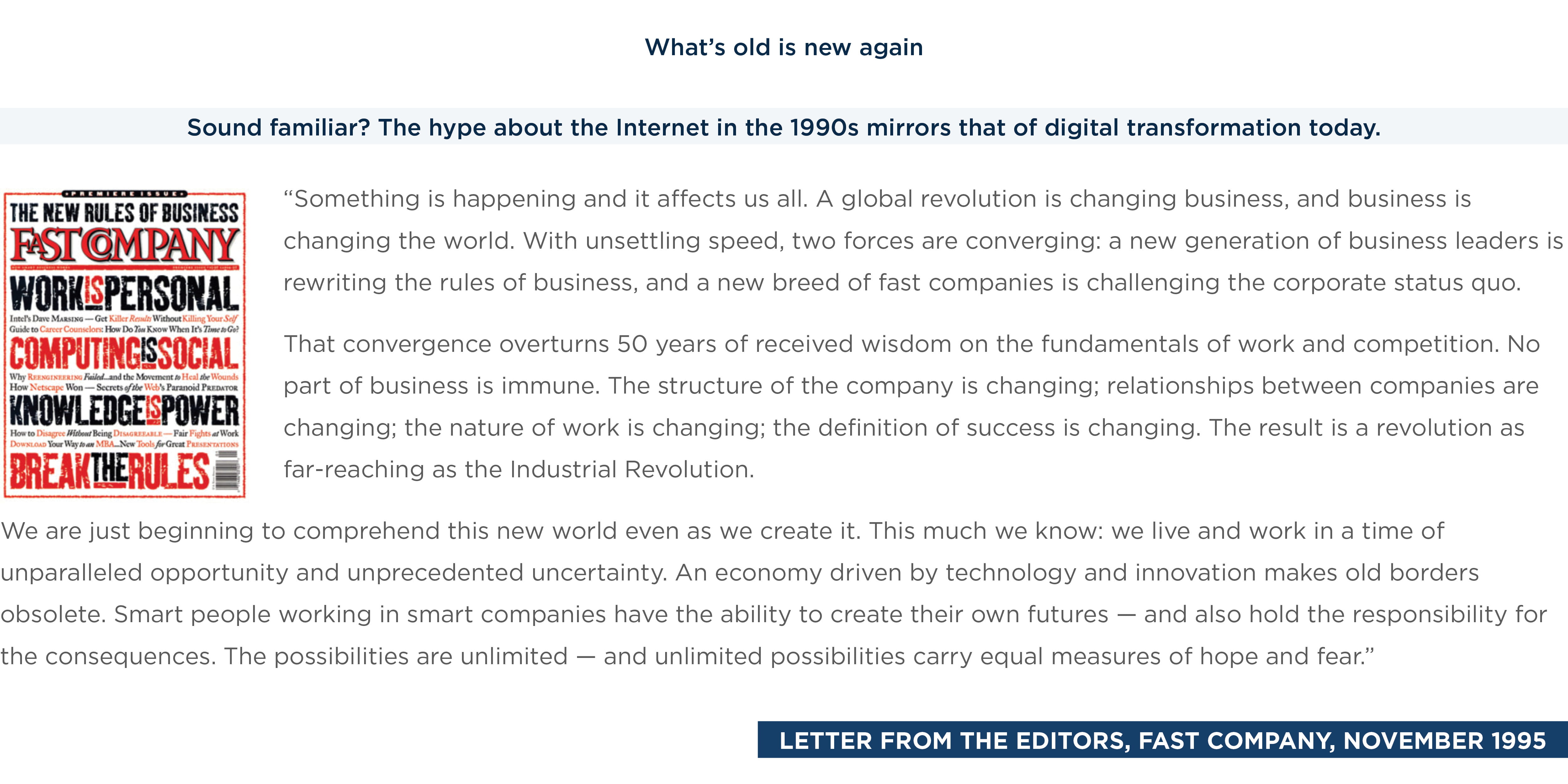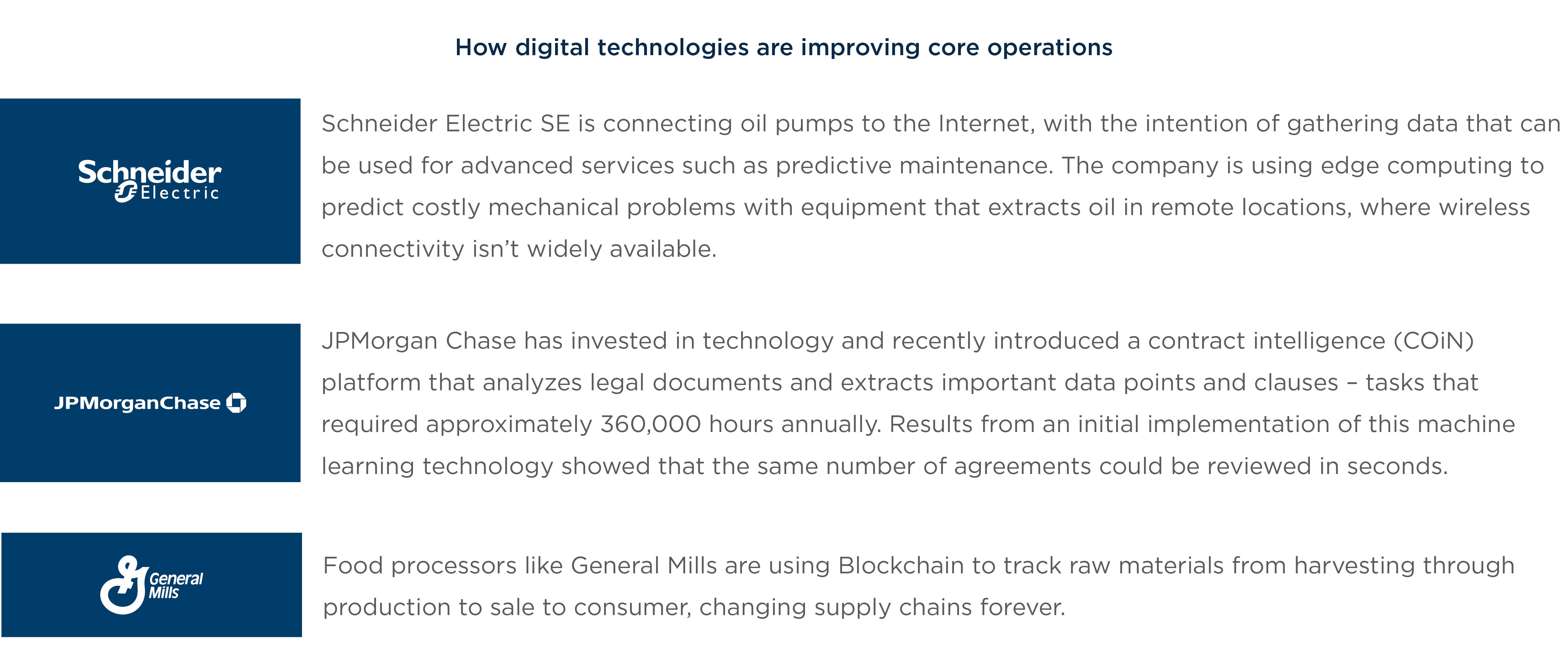
January 2018 | Point of View
Digital transformation: Separating hype from reality
We talk to executives who are in a panic about “digital transformation." But we have experienced these technology-driven hype cycles before.
Digital transformation: Separating hype from reality
Introduction
Just about every day, we talk to executives who are in a panic – quite literally – about how to proceed with “digital transformation.” The media paint a dim picture that businesses must become digital now, or risk survival. In turn, boards are asking questions and expecting satisfactory answers about their companies’ digital strategies and plans.
These executives feel the pressure to do something – but many admit they don’t really understand what “digital transformation” means or what to do next, let alone how to develop a compelling digital roadmap for the organization.
Our first response is usually this: Take a deep breath. Having worked in consulting for the past few decades, we have experienced these technology-driven hype cycles before.
In the early days, there was a push to automate using enterprise resource planning (ERP) technology. Then came the eCommerce/dot-com economy. Then came customer relationship management (CRM). Then came the cloud. Then came big data. Now, we have digital transformation.
The common denominator in all of these is that they are big, nebulous, new concepts purported to make the difference between thriving and surviving. In their infancy, each is so complex and unfamiliar that it caused some level of fear and panic. As we all know, panic often produces reactions we later regret.
What’s old is new again, or is it?
The mid-90s buzz around the “new economy” offers a particularly relevant comparison with digital transformation in terms of the pandemonium and grandiose language surrounding it – and a lesson for moving forward.
We recently came across some early issues of Fast Company, including one with an editorial about the emerging dot-com economy. It truly sounds like some of the same rhetoric we are reading today. Indeed, descriptions of the emerging dot-com world in the late-90s issues of business magazines are eerily similar to the language the industry is using today to position digital transformation. On the surface, both are all about speed, new ways of doing business, and unlocking the power of data. Below the surface, though, they are very different.
The “new economy” of the mid-90s was fueled by a rush to capitalize on an intriguing new channel – the Internet – that extended organizations’ reach, allowing them to break through geographical borders and access both existing and new markets more efficiently. Like today’s environment, the media warned of dot-coms that would push “traditional” companies out of business. In the rush to take businesses online, it was all about front-end marketing and design. Companies typically started with “brochure-ware” and replicating product catalogs online. Speed was critical, and converting existing print content was the fastest way to establish an online presence. Internet development skills were scarce, so companies hired any available consultancy or agency, at whatever cost was required.
Most organizations approached the Internet economy as an extension of the business they built on traditional channels. In other words, it broadened their operations but didn’t fundamentally change what already existed.
Like the new economy, the digital economy has spawned new channels for conducting business – including social media, mobile devices, and the Internet of Things (IoT). But unlike that previous era, the digital economy is not just about adding new channels to an existing business. It is about pervasive change in how companies organize and operate, driven by new capabilities such as machine learning, big data, agile methodologies, and blockchain technologies. For example, while mobile banking has become a critical channel for financial institutions, its underlying operational capabilities are enabling banks to differentiate themselves through that channel. Bank of America uses predictive analytics and cognitive messaging to integrate a chatbot named Erica into its mobile banking experience. The bot provides smart financial guidance and assists the company’s more than 45 million customers with daily transactions.
Where the dot-com economy required transforming the front of the house, the digital economy requires transforming the whole house, outside and inside the four walls – from the technology platforms on which operations run to culture to workforce skills to capabilities for capturing, managing, storing, consuming, and most importantly, capitalizing on the massive amounts of data coming from many sources. This is a bigger and much more complicated change. It’s hard to fault anyone who isn’t sure what to do next.
However, there is one lesson we can take from the mid-90s new economy. Just as today, the early days of the dot-com era produced a lot of hype, buzz, and uncertainty. Companies believed they had to do something, and fast. In a lot of cases, that led to expensive efforts that didn’t necessarily produce transformative results. Once the hype settled down, they were able to proceed with more clarity and with thoughtful, meaningful strategies that leveraged the Internet’s true capabilities to evolve their business models.
In other words, history tells us there is a good chance that what seems overwhelming now will likely come into sharper focus with time. The same will happen this time.
From nebulous concept to a practical course of action
Digital transformation will come into sharper focus. But before it does, we will still have to navigate a lot of dramatic talk. In our view, the best course is to relax (a bit) and find a way to begin translating a grandiose, unbounded concept into a practical course of action.
True transformation starts with meaningful and rational conversation within your organization. Find a “calming voice” – someone within your organization or an outside advisor – who can help your organization collaborate to craft its unique approach to digital transformation. This time around, it isn’t about throwing up a website ASAP. Every organization’s goal and path will be different. The important exercise right now is to find a sound starting point. If you do this well, there is a good chance the right next steps will become obvious.
Most companies already have their hands full simply trying to run a better business, so a prudent place to start is a process that your organization already has targeted for improvement. Good candidates can be industry-specific core processes – for example, claims adjudication for an insurance company, pricing for a manufacturer, mortgage lending for a bank, or field service for a utility. You don’t need to look far in the media to find good examples of companies whose primary focus is using digital technology to improve core operations rather than on wholesale digital transformation. Used smartly, emerging technologies can help you increase operational proficiency while also providing a way to ease into digital transformation.
Another useful activity is to learn from leaders, such as Amazon and Google. Observe what they do well and how they are innovating. For example, keeping data servers cool is a challenge for many organizations.
Google enlisted its artificial intelligence unit, DeepMind, to manage power in parts of its data-center operations, reducing the amount of power required for cooling by 40 percent. If you are considering whether the IoT could transform and differentiate your product suite, take a closer look at how Amazon employs IoT technology. Use these observations to develop some initial “big ideas” for your business.
While it is good to think big, it is important to start small, with rational, bite-sized projects that are relatively narrow in scope. Pick a concept that reflects one of the key tenets of digital transformation, such as using data differently or accelerating the speed at which you operate.
We often find it useful to start with the idea that, in the future, every company, regardless of business, will be a software company. For example, while most think of Amazon as a retail/distribution business, it is just as much if not more a technology company. Think about how this applies to your organization. If you run a bank, being a technology organization is not just about having a great mobile app. Rather, it might be about having a fully automated underwriting department that leverages algorithms and robots. This not only helps the bank execute underwriting processes faster and more accurately, it frees up people to do what they do best and what machines are challenged to do – handle tasks that involve relating to customers and their emotions. This produces a smoother, faster loan-origination experience for the customer – and good experience breeds loyalty.
And on the subject of starting small, we have found that it can be helpful to start with a targeted project in a small unit of the business. Consider this example: A distribution organization specializes in food and beverage products, but it has several small specialty business units, including a consumer soft lines unit that comprises approximately 10 percent of its business. Targeting that unit for a digital pilot can help the organization gain valuable experience without the complexity of changing core operations.
While a large utility like Exelon is navigating wholesale modernization of its core operations, it also offers an example of how a targeted effort in a smaller, non-core unit of the organization – in this case, customer service – can advance digital transformation. Exelon is developing a chatbot that relies on natural language processing and artificial intelligence to understand conversations and provide clear answers. Soon, this capability will allow customers to use various messaging platforms and digital assistants to ask billing and outage questions.
The point is, choose a discrete, manageable opportunity. Go through the process of developing it, learn from it, and then expand your digital roadmap from there.
Remember, you’ve probably been here before
The media and, frankly, many consultants will have us believe that we must be digital tomorrow or our prospects are dim. For most businesses, that is overwhelming – and being overwhelmed usually leads to one of two things: knee-jerk reactions or inability to do anything at all (i.e., analysis paralysis).
Keep in mind that digital transformation is likely to be a five- to seven-year process. For all the talk of digital disruptors that will put companies out of business overnight, there are few case studies of that actually happening. Those that have perished have done so for reasons in addition to simply having a new, unexpected digital competitor.
Eventually, the hype will quiet down, and clear and rational approaches will take hold. How can we be so sure? This is what we do every day as consultants – we turn nebulous, complicated concepts and goals into rational, step-by-step plans. It works. That is how we have navigated through every other hype cycle, and that is how we will get through digital transformation.
For now, take that deep breath. Look at your organization’s current strategic, operational, and financial goals and use those to frame your approach to becoming digital. Instead of rushing to create a digital strategy, focus on evolving your business strategy for success in the digital world.


